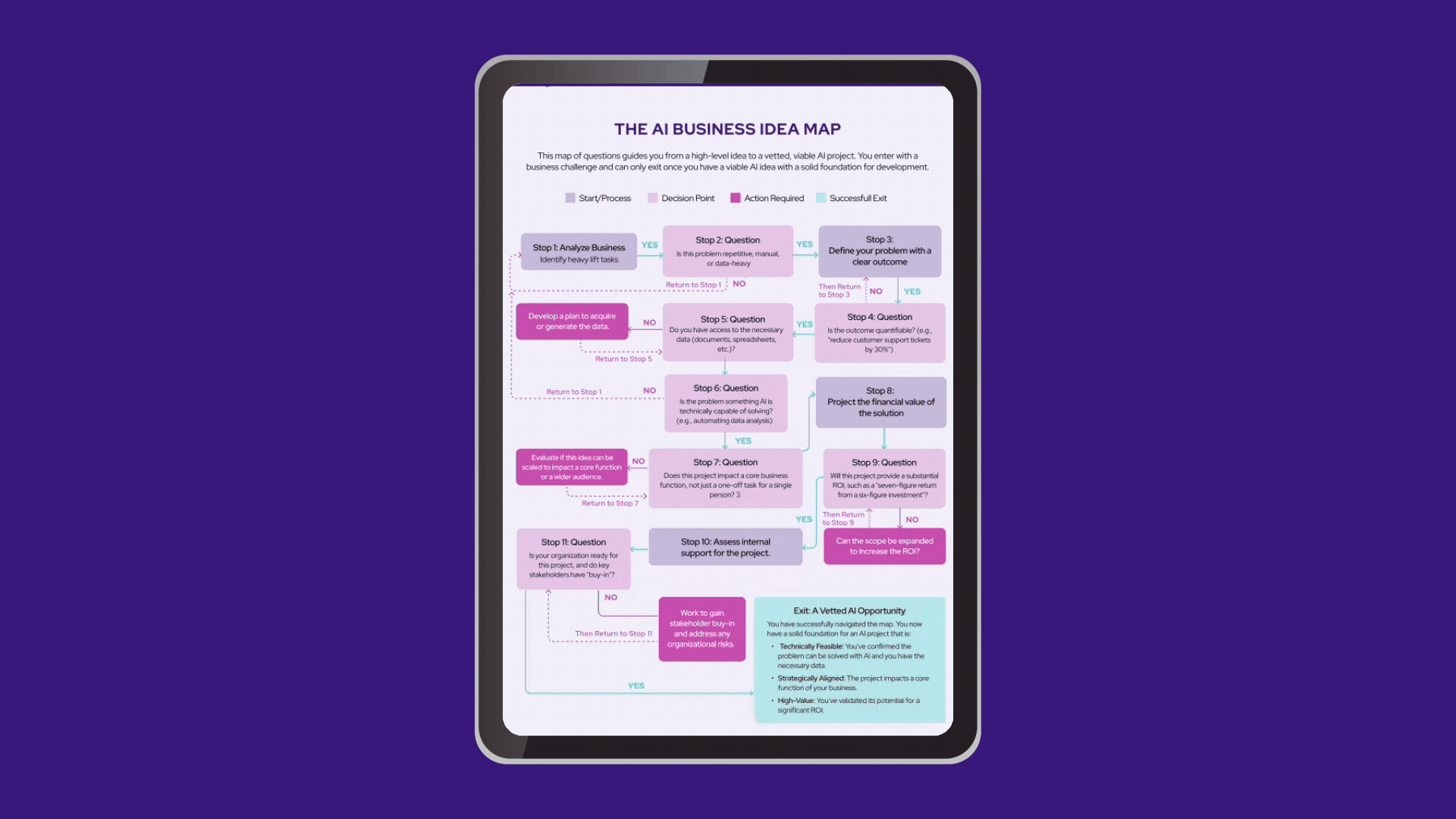
There’s a persistent fear in the startup world: if you outsource your tech project without having a CTO, engineer, or anyone “technical” on your team, you’ll end up paying hundreds of thousands for a broken, vibe-coded prototype that barely functions.
This belief isn’t entirely wrong, and many founders have been burned by agencies that overpromise and underdeliver. But it’s not the whole story either. Non-technical founders have successfully built billion-dollar companies through outsourcing: from Jack Ma, who openly admits he can’t code, to Slack, whose founders hired an external agency to design the product that millions use today.
So, when does outsourcing without in-house tech expertise actually work, and how can you make sure it works for you?
If you’re still shaping your project, we have Business Idea Map – a framework that will help you transform a vague AI idea into a clear, validated, and development-ready business opportunity.

The warnings about outsourcing without technical oversight come from real risks — but those risks stem from structural gaps, not from founders lacking a CS degree.
Here’s why everyone insists on having a “tech person”:
These are real dangers. But they don’t mean you can’t outsource successfully, but rather mean you need the right system of control to replace technical oversight.
Download our guide “Understanding AI Engineering for Non-Technical Leaders” if you want to communicate with developers more effectively.
Plenty of companies have proved that outsourcing can work beautifully, even without in-house technical leadership. The key is clarity, governance, and smart delegation.
Outsourcing worked for these founders because they kept ownership of direction and decision-making while outsourcing execution under strong structural safeguards.
You don’t need to become a tech expert. You just need to replace missing expertise with structured governance. And here’s what you can do:
Even if you don’t understand the code, your contract can make sure you stay in control. Include clauses that guarantee:
You don’t need to read code to know if it’s good. Agree with your agency to use automated code review tools that show the health of your software in clear dashboards.
Popular options include SonarQube, Codacy, and Qodana — they automatically scan every code update for errors, messy structure, or security issues and show simple red-yellow-green status indicators.
Ask your team to:
This keeps development transparent and gives you visible proof of quality, without needing to understand a single line of code.
Avoid the classic “code hostage” situation by keeping ownership of everything from day one:
A Fractional CTO is a part-time senior technical advisor who acts as your “technical firewall.”
They don’t write code — they protect your investment by:
A Fractional CTO costs far less than a full-time hire but can save you hundreds of thousands by preventing major mistakes.
So, outsourcing your software project is only risky if you don’t set up the right structure, don’t stay in control, and, of course, choose the wrong partner.
With clear contracts, transparent quality checks, and ownership over your assets, you can manage an outsourced project confidently, and when you work with an agency that values communication, accountability, and results, everything else falls into place.
At NineTwoThree, we’ve helped over 160 startups and enterprises build products that scale, combining business clarity with deep technical execution. We understand what makes outsourced development succeed, and we’ve built our process around making it stress-free for you.
Ready to build your product with confidence? Let’s talk about your project.
Not sure if you're AI-ready? We have a free tool to help you figure out! Take the AI readiness assessment

There’s a persistent fear in the startup world: if you outsource your tech project without having a CTO, engineer, or anyone “technical” on your team, you’ll end up paying hundreds of thousands for a broken, vibe-coded prototype that barely functions.
This belief isn’t entirely wrong, and many founders have been burned by agencies that overpromise and underdeliver. But it’s not the whole story either. Non-technical founders have successfully built billion-dollar companies through outsourcing: from Jack Ma, who openly admits he can’t code, to Slack, whose founders hired an external agency to design the product that millions use today.
So, when does outsourcing without in-house tech expertise actually work, and how can you make sure it works for you?
If you’re still shaping your project, we have Business Idea Map – a framework that will help you transform a vague AI idea into a clear, validated, and development-ready business opportunity.

The warnings about outsourcing without technical oversight come from real risks — but those risks stem from structural gaps, not from founders lacking a CS degree.
Here’s why everyone insists on having a “tech person”:
These are real dangers. But they don’t mean you can’t outsource successfully, but rather mean you need the right system of control to replace technical oversight.
Download our guide “Understanding AI Engineering for Non-Technical Leaders” if you want to communicate with developers more effectively.
Plenty of companies have proved that outsourcing can work beautifully, even without in-house technical leadership. The key is clarity, governance, and smart delegation.
Outsourcing worked for these founders because they kept ownership of direction and decision-making while outsourcing execution under strong structural safeguards.
You don’t need to become a tech expert. You just need to replace missing expertise with structured governance. And here’s what you can do:
Even if you don’t understand the code, your contract can make sure you stay in control. Include clauses that guarantee:
You don’t need to read code to know if it’s good. Agree with your agency to use automated code review tools that show the health of your software in clear dashboards.
Popular options include SonarQube, Codacy, and Qodana — they automatically scan every code update for errors, messy structure, or security issues and show simple red-yellow-green status indicators.
Ask your team to:
This keeps development transparent and gives you visible proof of quality, without needing to understand a single line of code.
Avoid the classic “code hostage” situation by keeping ownership of everything from day one:
A Fractional CTO is a part-time senior technical advisor who acts as your “technical firewall.”
They don’t write code — they protect your investment by:
A Fractional CTO costs far less than a full-time hire but can save you hundreds of thousands by preventing major mistakes.
So, outsourcing your software project is only risky if you don’t set up the right structure, don’t stay in control, and, of course, choose the wrong partner.
With clear contracts, transparent quality checks, and ownership over your assets, you can manage an outsourced project confidently, and when you work with an agency that values communication, accountability, and results, everything else falls into place.
At NineTwoThree, we’ve helped over 160 startups and enterprises build products that scale, combining business clarity with deep technical execution. We understand what makes outsourced development succeed, and we’ve built our process around making it stress-free for you.
Ready to build your product with confidence? Let’s talk about your project.
Not sure if you're AI-ready? We have a free tool to help you figure out! Take the AI readiness assessment

